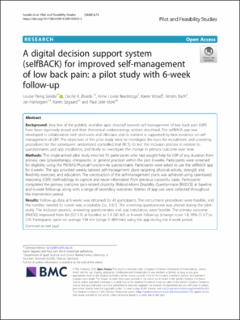| dc.contributor.author | Sandal, Louise Fleng | |
| dc.contributor.author | Øverås, Cecilie K. | |
| dc.contributor.author | Nordstoga, Anne Lovise | |
| dc.contributor.author | Wood, Karen | |
| dc.contributor.author | Bach, Kerstin | |
| dc.contributor.author | Hartvigsen, Jan | |
| dc.contributor.author | Søgaard, Karen | |
| dc.contributor.author | Mork, Paul Jarle | |
| dc.date.accessioned | 2022-05-04T10:11:53Z | |
| dc.date.available | 2022-05-04T10:11:53Z | |
| dc.date.created | 2020-10-21T10:39:47Z | |
| dc.date.issued | 2020 | |
| dc.identifier.issn | 2055-5784 | |
| dc.identifier.uri | https://hdl.handle.net/11250/2994109 | |
| dc.description.abstract | Background
Very few of the publicly available apps directed towards self-management of low back pain (LBP) have been rigorously tested and their theoretical underpinnings seldom described. The selfBACK app was developed in collaboration with end-users and clinicians and its content is supported by best evidence on self-management of LBP. The objectives of this pilot study were to investigate the basis for recruitment and screening procedures for the subsequent randomized controlled trial (RCT), to test the inclusion process in relation to questionnaires and app installation, and finally to investigate the change in primary outcome over time.
Methods
This single-armed pilot study enrolled 51 participants who had sought help for LBP of any duration from primary care (physiotherapy, chiropractic, or general practice) within the past 8 weeks. Participants were screened for eligibility using the PROMIS-Physical-Function-4a questionnaire. Participants were asked to use the selfBACK app for 6 weeks. The app provided weekly tailored self-management plans targeting physical activity, strength and flexibility exercises, and education. The construction of the self-management plans was achieved using case-based reasoning (CBR) methodology to capture and reuse information from previous successful cases. Participants completed the primary outcome pain-related disability (Roland-Morris Disability Questionnaire [RMDQ]) at baseline and 6-week follow-up along with a range of secondary outcomes. Metrics of app use were collected throughout the intervention period.
Results
Follow-up data at 6 weeks was obtained for 43 participants. The recruitment procedures were feasible, and the number needed to screen was acceptable (i.e., 1.6:1). The screening questionnaire was altered during the pilot study. The inclusion process, answering questionnaires and app installation, were feasible. The primary outcome (RMDQ) improved from 8.6 (SD 5.1) at baseline to 5.9 (SD 4.0) at 6-week follow-up (change score 1.8, 95% CI 0.7 to 2.9). Participants spent on average 134 min (range 0–889 min) using the app during the 6-week period.
Conclusion
The recruitment, screening, and inclusion procedures were feasible for the subsequent RCT with a small adjustment. The improvement on the RMDQ from baseline to follow-up was small. Time pattern of app usage varied considerably between the participants. | en_US |
| dc.language.iso | eng | en_US |
| dc.publisher | BMC | en_US |
| dc.rights | Navngivelse 4.0 Internasjonal | * |
| dc.rights.uri | http://creativecommons.org/licenses/by/4.0/deed.no | * |
| dc.title | A digital decision support system (selfBACK) for improved self-management of low back pain: a pilot study with 6-week follow-up | en_US |
| dc.title.alternative | A digital decision support system (selfBACK) for improved self-management of low back pain: a pilot study with 6-week follow-up | en_US |
| dc.type | Peer reviewed | en_US |
| dc.type | Journal article | en_US |
| dc.description.version | publishedVersion | en_US |
| dc.source.volume | 6 | en_US |
| dc.source.journal | BMC Pilot and Feasibility Studies | en_US |
| dc.source.issue | 72 | en_US |
| dc.identifier.doi | 10.1186/s40814-020-00604-2 | |
| dc.identifier.cristin | 1841118 | |
| cristin.ispublished | true | |
| cristin.fulltext | original | |
| cristin.qualitycode | 1 | |

